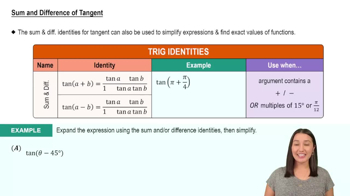Textbook Question
Use the given information to find tan(s + t). See Example 3.
cos s = -15/17 and sin t = 4/5, s in quadrant II and t in quadrant I
576
views
 Verified step by step guidance
Verified step by step guidance Verified video answer for a similar problem:
Verified video answer for a similar problem:



 6:14m
6:14mMaster Sum and Difference of Sine & Cosine with a bite sized video explanation from Patrick
Start learning